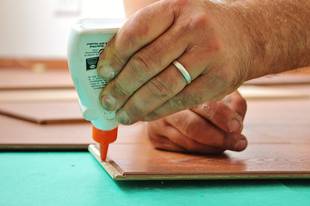
When glue is warmed, it changes its form gradually from the solid to the liquid state. Substances that melt gradually are called viscous substances, another way of saying that their molecules tend to stay together.
The force that holds molecules of a substance together is called cohesion. Glue has another force, that of adhesion, by which its molecules will stick to, or adhere to, molecules of other substances, such as wood, cloth or paper.
We glue two pieces of wood together by smearing both pieces with liquid glue and press them together. The glue is forced into the hollow air spaces of the wood, against the walls of the cell cavities. When the glue hardens, it is firmly anchored in each piece of wood. The structure is held together by adhesion of glue to wood and cohesion of glue to glue. Both forces are necessary for the pieces to hold together; but adhesion is the stronger force here. Therefore, a thin layer of glue will hold things together more firmly than a thick layer.


















